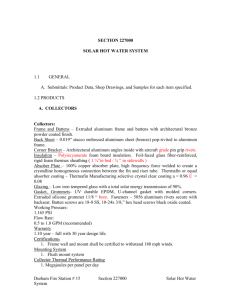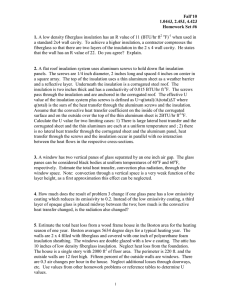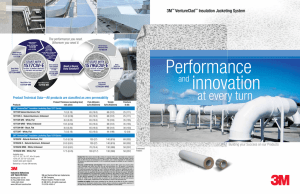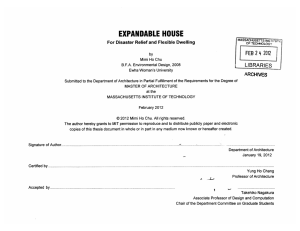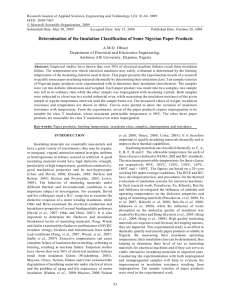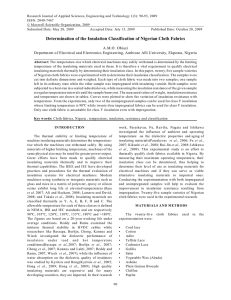display
advertisement
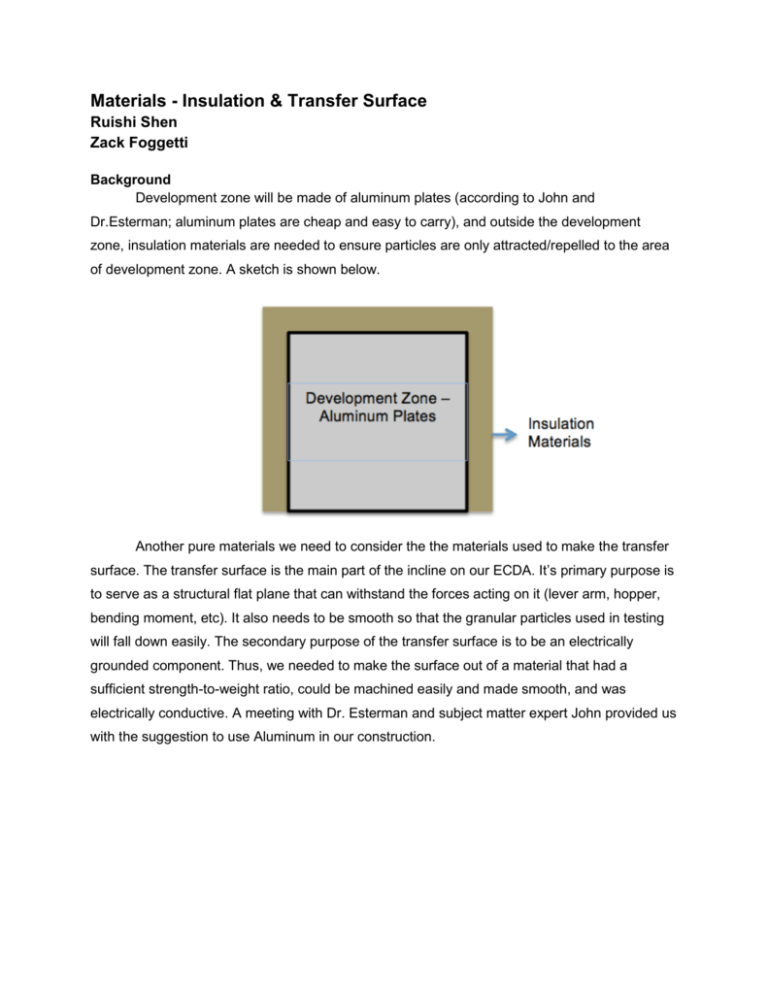
Materials - Insulation & Transfer Surface Ruishi Shen Zack Foggetti Background Development zone will be made of aluminum plates (according to John and Dr.Esterman; aluminum plates are cheap and easy to carry), and outside the development zone, insulation materials are needed to ensure particles are only attracted/repelled to the area of development zone. A sketch is shown below. Another pure materials we need to consider the the materials used to make the transfer surface. The transfer surface is the main part of the incline on our ECDA. It’s primary purpose is to serve as a structural flat plane that can withstand the forces acting on it (lever arm, hopper, bending moment, etc). It also needs to be smooth so that the granular particles used in testing will fall down easily. The secondary purpose of the transfer surface is to be an electrically grounded component. Thus, we needed to make the surface out of a material that had a sufficient strength-to-weight ratio, could be machined easily and made smooth, and was electrically conductive. A meeting with Dr. Esterman and subject matter expert John provided us with the suggestion to use Aluminum in our construction. Design Decisions & Research For insulation materials, please see Pugh Chart below (Alternatives are selected if they are common in market) Based on the results shown in the Pugh Chart above, plastic is chosen as the insulation materials that will be used to separate the plates of development zone. It is relatively robust while still fairly easy to cut, and it is not too expensive. The team is also able to get it on time after purchasing it (it does not have long of a lead time as ceramic does). There were also other criteria during the concept selection process such as “the insulation material should be guaranteed to be non-conductive under 0.4kV”, which is the highest voltage our power supply can go. However when doing the Pugh Chart, the team realized that that is a fairly low standard that all the alternatives selected will meet. For example, vinyl electrical tape is guaranteed to be non-conductive under 0.6kV (reference website: http://multimedia.3m.com/mws/media/765027O/iatd-product-info.pdf). Also, even low-voltage insulating paper can deal with at least 35kV of voltage (reference website: http://www.ndpaper.com/eng/business/insulating.htm) Therefore the criteria is not included in the Pugh Chart. For materials of transfer surface, more research into Aluminum was done to validate why it would be a suitable solution. Firstly, Aluminum (specifically 6061-T6) has a yield strength of 276 MPa, which should be sufficiently strong for our use, as well as keep the thickness of the transfer surface minimized. It has a density of around 2,700 kg/m3, making it one of the lightest metals to choose from, and thereby keeping the weight of our unit minimized. Aluminum is readily available, inexpensive, and relatively easy to machine. Finally, it has an electrical conductivity of 3.5 x 107 S/m, making it at least 5 times more conductive than steel. Below is a table of the design options we have. Material Description Yield Strength (psi) Cost (12x12x.125 in.) 6061 Multipurpose 35,000 $28 2024 High Strength 41,000 $44 7075 Hard High Strength 61,000 $48 Prices are approximate and are quoted from: http://www.mcmaster.com/#standardaluminum-sheets/=ubtq97. The cost per square foot is given only as a reference for comparison. Final selection of the material and dimensions will be largely determined by the final weight and design of the hopper, as well as overall budget constraints. Flow Down Explanation Even though this is not one of the customer requirements, however, after talking with Dr. Chang, she stated that it would be better to use some insulation materials to surround the development zone to better collect charged particles. Materials Chosen Plastic sheets can be purchased from the website below: http://www.professionalplastics.com/PLASTICSHEETS?&search_id=1745921 Prices need to be quoted from the website. Getting the exact price is part of the project plan for the next three weeks. The price range for plastic sheeting is from $3.00 to $50.00. Estimated Budget $30.00 -- Insulation Materials Risk Assessment Plan References http://multimedia.3m.com/mws/mediawebserver?mwsId=XXXXXZz15hKxQaYyTBkEQakhJ_zVJ hz14_8XJ_8XJXXXXXX-www.professionalplastics.com http://materias.fi.uba.ar/6209/download/insulate.pdf http://www.mcmaster.com/#standard-aluminum-sheets/=ubtq97 http://en.wikipedia.org/wiki/Electrical_resistivity_and_conductivity http://www.engineeringtoolbox.com/metal-alloys-densities-d_50.html http://www.matweb.com/search/datasheet_print.aspx?matguid=1b8c06d0ca7c456694c7777d9e 10be5b




